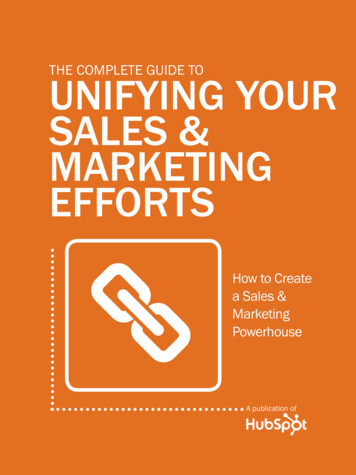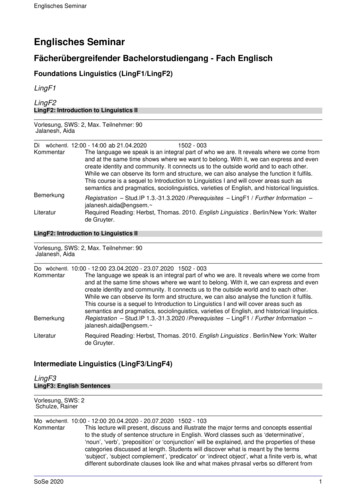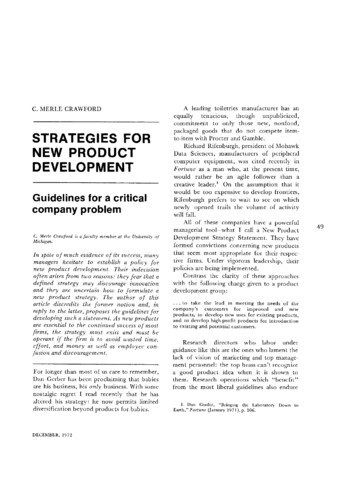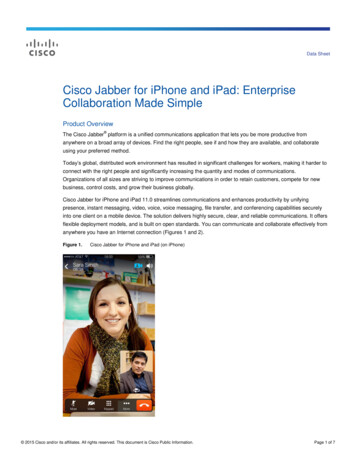
Transcription
1THE complete guide to unifying your sales & marketing effortsThe complete Guide tounifying yoursales &marketingeffortsaHow to Createa Sales &MarketingPowerhouseA publication ofShare This Ebook!www.Hubspot.com
2THE complete guide to unifying your sales & marketing effortsIS THIS eBOOK RIGHT FOR ME?Not quite sure if this ebook is right for you? See the below description to determine ifyour level matches the content you are about to read.INTRODUCTORYIntroductory content is for marketers who are new to the subject.This content typically includes step-by-step instructions on howto get started with this aspect of inbound marketing and learnits fundamentals. Watch our introductory webinar 5 Steps toEstablishing an Effective Sales & Marketing Methodology.INTERMEDIATEIntermediate content is for marketers who are familiar with thesubject but have only basic experience in executing strategies andtactics on the topic. This content typically covers the fundamentalsand moves on to reveal more complex functions and examples.Read our intermediate ebook All You Need to Know About AligningSales & Marketing.ADVANCEDThis ebook!Advanced content is for marketers who are, or want to be, expertson the subject. In it, we walk you through advanced features ofthis aspect of inbound marketing and help you develop completemastery of the subject. After reading it, you will feel ready not onlyShare This Ebook!www.Hubspot.comto execute strategies and tactics, but also to teach others how tobe successful.
3THE complete guide to unifying your sales & marketing effortsHubSpot’s All-in-OneMarketing Software. brings your whole marketing world together in one, powerful, integrated system.Get Found: Help prospects find you onlineConvert: Nurture your leads and drive conversionsAnalyze: Measure and improve your marketingPlus more apps and integrationsRequest A DemoVideo OverviewU qLeadGenerationM sEmail &Automationwww.Hubspot.comSearchoptimizationg YLeadmanagementShare This Ebook!blogging &social mediaMarketinganalytics
4THE complete guide to unifying your sales & marketing effortsthe complete guide to unifyingyour sales & marketing effortsBy Ellie MirmanEllie leads the marketing for HubSpot’smid-sized business segment. Since joiningin September 2007, she’s worked oneverything from lead generation to productmarketing, and somewhere along the way,learned that she absolutely loves being apart of a fun and hard-working startup likeHubSpot.Ellie’s specialties lie in lead generation,email marketing, and product marketing.She also has experience with eventmarketing, launching the first ever InboundMarketing Summit in 2008, and growingnew lead generation programs, includingHubSpot’s monthly webinar series attractingthousands of registrants to each event.Share This Ebook!www.Hubspot.comFollow me on twitter@ellieeille
5THE complete guide to unifying your sales & marketing effortsContentssetting up CLOSED-LOOP REPORTING/8how to DEFINE YOUR FUNNEL stAGES/18IMPLEMENTing A service-level agreement (SLA)a deep dive into dashboards & reporting/36how to hold effective smarketing meetingS /48ideas for other smarketing communicationconclusion & additional resourceSShare This Ebook!www.Hubspot.com/58/54/28
6“THE complete guide to unifying your sales & marketing effortsMistrust andmiscommunicationbetween sales andmarketing can act likean anchor on yourcompany’s growth rate.By now, most marketers understand theimportance of mending the traditional riftbetween sales and marketing. The mistrustand miscommunication that’s so oftenfound between the two teams can act like ananchor on your company’s growth rate. ”aIn fact, organizations with good alignment betweensales and marketing teams achieved 20% annualrevenue growth in 2010, according to a study by theAberdeen Group. By contrast, companies with pooralignment saw revenues decline by 4%.While many companies work hard to generate better communication between salesand marketing, cracks between the two groups reopen over time. The bottom linethatEbook!achieving sales and marketing alignment can be tough, but maintainingShareisThisalignment is even tougher.www.Hubspot.com
7THE complete guide to unifying your sales & marketing effortsfreewebinarHubSpot’s 2012 webinar with salesforce.com explores how companies can establishan effective alignment between sales and marketing departments. If you missed thelive event, you can watch the on-demand recording with Linda Crawford, EVP & GMof Sales Cloud at salesforce.com, and Mike Volpe, HubSpot’s CMO. The two leadersshare lessons based on established internal practices as well as analytical insightsfrom both HubSpot and data.com.Share This Ebook!www.Hubspot.com
8THE complete guide to unifying your sales & marketing effortsCreating a solid, lasting partnership between sales and marketing requires a strategicapproach that treats the two teams as a single, revenue-generating organization. AtHubSpot, we call this organization the “Smarketing” team to recognize the fact thatsales and marketing are critical partners. This perspective has helped our teamsmaintain strong ties even as we’ve grown from a handful of people to more than 100staff members.sales marketing]SMarketingThe key to the Smarketing approach is implementing a framework of data-driventools and practices that help sales and marketing teams work better together. Oncehard numbers have defined key stages of your funnel and outlined each team’sexpectations, there’s a lot less room for sales and marketing to argue about eachother’s performance. The results are plain for everyone to see.This ebook will teach you the science of sales and marketing alignment and show youhow to implement the six key elements of the Smarketing framework. In this way, thegains you achieve from better collaboration between sales and marketing can last inthe long term.Share This Ebook!www.Hubspot.com
9THE complete guide to unifying your sales & marketing effortsCHAPTER 1setting upCLOSED-LOOPREPORTINGShare This Ebook!www.Hubspot.com
10THE complete guide to unifying your sales & marketing efforts“Using closed-loop data you can seewhich marketing programs deliverthe best bang for your buck.”Data is the crucial ingredient for maintainingsales and marketing alignment. You need datato monitor progress toward goals, analyze leadquality, and measure marketing ROI. So thefirst step in creating a Smarketing organizationis establishing a closed-loop reporting systemthat tracks key marketing and sales metrics.The two key pieces of this system are:Marketing softwareMarketing software like HubSpot that helps you generate and manage leads.CRM (Customer Relationship Management) like salesforceCRM like saleforce.com that helps you track and measure sales activities.Share This Ebook!www.Hubspot.com
11THE complete guide to unifying your sales & marketing effortsZSharing the Same DataThese two systems must be integrated toshare data on every lead from creationthrough opportunity stage to close, so youcan build reports that show the close rate andnew customers from the leads generated bymarketing. Many marketing software platformsintegrate with CRM systems. For example,HubSpot’s marketing platform integrates withsalesforce.com, SugarCRM, Microsoft Dynamics,marketingsoftwareCRMNetSuite, Sage and several others.Other features you should look for in a closed-loop marketing system include:.Automatic synchronization between the marketing platform and your CRM.De-duplication of leads by matching on email address and tracking information,so as leads come back to your website you are updating existing lead recordsnot creating duplicate leads.The ability to pull information from the CRM into the marketing platform,allowing you to segment your leads by data the sales team has added to thelead or contact records.Share This Ebook!www.Hubspot.com
12THE complete guide to unifying your sales & marketing effortswInformation SharingNext, start sharing information betweenthe two platforms to help improve theperformance of both sales and marketing.What should marketingshare with sales?Complete lead intelligenceiComplete lead intelligence includes the history of each lead’s activity onyour website like campaign engagement, download history, and social mediapresence. Appending these details to each lead record helps sales reps plantheir follow-up strategies and find hooks to start that first conversation.Lead alerts.Lead alerts are email messages or other notifications when a lead revisits yourwebsite, completes an important form, or takes another key action, such asrequesting to speak with a salesperson.These types of insights are available in integrated marketing software platforms likeHubSpot. See examples of both lead intelligence and lead alerts on the next page.Share This Ebook!www.Hubspot.com
13THE complete guide to unifying your sales & marketing effortsleadintelligenceShare This Ebook!www.Hubspot.comleadrevisitalerts
14THE complete guide to unifying your sales & marketing effortsWhat should salesshare with marketing?Your sales team also needs to keepwmarketing informed on their activities. Hereare some suggestions for the type ofinsights sales can share with marketing:Contact Touchesi.Records of email and call attempts and connects.Lead Status UpdatesUpdates on lead status, such as open, in progress, qualified and unqualified.Revenue NumbersData on closed deals and the revenue associated with each contract tocalculate marketing effectiveness and ROI.These types of insights are available in CRM solutions like salesforce.com. See thenext page for examples of lead intelligence, contact touches and forecast views.Using this closed-loop data, you can track how each customer progressed throughyour marketing funnel and see which marketing programs are delivering the bestbang for your buck. Getting your hands on this sales data in real time can help you bean agile marketer and make effective iterations to your campaigns.Share This Ebook!www.Hubspot.com
15Share This Ebook!www.Hubspot.comTHE complete guide to unifying your sales & marketing efforts
16THE complete guide to unifying your sales & marketing effortsIdentify Winning Marketing ChannelsTrace each customer back to the source oftheir first visit to your website – e.g., paidprograms, organic search, social media, oremail marketing. You should analyze eachchannel for key metrics such as:Visits per channelLeads per channel;Visit-to-lead ratio per channelLead-to-customer ratio per channelUse this data to optimize your marketing mix and focus on the channels that aredelivering the best conversion metrics.Share This Ebook!www.Hubspot.com
17THE complete guide to unifying your sales & marketing effortsIdentify Winning Marketing AssetsExamine the lead history of each customer andrecord every marketing touch and action thatoccurred between lead capture and close.By calculating the percentage of customerswho visited a specific page on your site prior toconversion, or who viewed a particular webinar orebook, you can identify the most effective content inyour marketing funnel. HubSpot’s Conversion Assiststool provides this type of analysis.Share This Ebook!www.Hubspot.comx
18THE complete guide to unifying your sales & marketing effortsThis process also can include a review of specific market campaigns to determinewhich generated the most leads and customers. Or, you can look at which of yourlanding pages reached a higher-than-average conversion rate. The insights you gainfrom these reports can help you fine-tune your content strategy or optimize your siteto promote more influential pages. For instance, check out HubSpot’s Landing Pagedashboard and some of the metrics we keep an eye on here:Share This Ebook!www.Hubspot.com
19THE complete guide to unifying your sales & marketing effortsCHAPTER 2how to DEFINEYOUR FUNNELstAGESShare This Ebook!www.Hubspot.com
20“THE complete guide to unifying your sales & marketing effortsSales and marketing must have aunified picture of the funnel.”Sales and marketing teams often have a very different picture of the funnel. Theymight disagree about the number of stages a lead passes through before becoming acustomer – and they often use different terminology to describe those stages.To adopt an effective Smarketing strategy, sales and marketing must have a unifiedpicture of the funnel and standard definitions of each stage in the process. Forexample, HubSpot’s Smarketing team uses the following funnel stages:VISITSmarketingqualified leadsLEADSsales acceptedleadsopportunitiescustomersShare This Ebook!www.Hubspot.com
21THE complete guide to unifying your sales & marketing effortsUnderstand Lead QualityFocus on the definition of a Marketing Qualified Lead (MQL). This is the crucial handoff point between marketing and sales, so it’s essential that the teams agree on theterminology.Every company’s definition of an MQL will vary, but it should reflect a combination oftraits and actions that indicate a lead is both a good fit for your company and readyto talk to a salesperson. Here’s one way to examine your funnel to assess lead qualityand determine whether a lead is ready for sales follow-up:FitstimulateinterestavoidShare This erest
22THE complete guide to unifying your sales & marketing effortsAspects of Lead Qualification1Is the lead a good fit?Your company might target financial services companies with 5,000 or moreemployees, or small service businesses with fewer than 100 employees. Or, you maybe only interested in manufacturing companies of any size. Within those categories,you also might identify individual lead profiles, such as title or job description and rolein the decision-making process – e.g., economic buyer, end user, influencer.How closely a lead hews to your ideal customer profile will determine whether andwhen you hand it over to the sales team.2Is the lead interested?A lead’s activity can reveal how close they are to a buying decision. For example, ifa lead has only visited your website once, or has just begun following you on Twitter,they may be aware of your company but aren’t particularly engaged yet. A lead thatrequests a demo or views pricing information is showing a lot more interest.Share This Ebook!www.Hubspot.com
23THE complete guide to unifying your sales & marketing effortsWhere a lead falls within the four quadrants of this matrix dictates the next step yourmarketing or sales team should take. For example:FitGood FIT & InterestedLeads in upper right quadrant are a good fit for yourcompany and are highly engaged with your marketing.These are hot leads that require immediate follow-upfrom your sales team – usually in less than 24 hours.InterestFitGood fit but less interestLeads in the upper left quadrant are a good fit for yourcompany, but don’t show a lot of interest yet. Perhapsthey’ve only signed up for an email newsletter ordownloaded one piece of educational content. Theseare leads that the marketing team needs to nurture.Share This Ebook!www.Hubspot.comInterest
24THE complete guide to unifying your sales & marketing effortsLots of interest but not a good fitFit.Leads in the lower right don’t necessarily fit yourideal customer profile, but are highly engaged withyour brand. They might have subscribed to your blogand email newsletter, downloaded your ebooks, andattended your webinars. It’s worth having a sales rep doInteresta low-cost follow-up with these fans to see if there’san easy sale to make from a non-traditional customer.Sometimes leads that don’t seem like a fit have a good reason to buy your product.They can also turn into great evangelists for your products or services, thus providingyou with indirect support as non-customers. That’s why you can’t automate the entiresales and marketing process. At some point, a good marketer or sales rep can spotan opportunity that your systems might overlook.Little Interest & No fitFit.Leads in the lower left quadrant aren’t a good fit foryour company and haven’t shown much interest inyour marketing content. They’re definitely not wortha sales rep’s time. Don’t be afraid to take them outof your communication stream.InterestShare This Ebook!www.Hubspot.com
25THE complete guide to unifying your sales & marketing effortsDevelop Your Definition of an MQLUsing this matrix as your guide, develop an MQL definition based on the combinationof fit and interest that’s right for your company. Some marketers may focus more onfit because they have a tightly defined market; other marketers may have a broadcustomer base and focus more on interest level. That decision depends on yourbusiness model.MQL definitions in those two cases might look like this:A contact with XYZ title or role who hasfilled out a landing page form and worksat a financial services company in theU.S. with more than 5,000 employees.A contact with the ABC title or role whohas requested a product demonstrationfrom a sales rep and works at any U.S.based company.Whichever approach you chose, base your definitions on data – not on gutinstinct. Even experienced marketers and salespeople can be way off base in theirassumptions about what makes a good lead.Share This Ebook!www.Hubspot.com
26THE complete guide to unifying your sales & marketing effortsExample of Lead ScoringHere is an example of what lead scoring can look like for you:Using a lead scoring or lead grading program that relies on data from your closedloop analysis can help you determine the importance of different activities.Share This Ebook!www.Hubspot.com
27THE complete guide to unifying your sales & marketing effortsHow You Can Do ItExamine Behavioral HistoryExamine the activity history of recent customers and analyze how many actions theytook before becoming a customer – i.e., the number of page views or number ofconversions, such as downloading a report or registering for a webinar, etc.Find PatternsLook for patters that indicate a lead’s likelihood of closing. For example, if a leadthat downloads ten pieces of content from your website or visits your site more than15 times in one month, she is more likely to close. Consider incorporating frequencymeasures in your MQL definition.list activities.Also, list all the activities that a lead can take before becoming a customer, andanalyze the close rate for each one.For example, to determine the close rate for a webinar, look at all customers thathad watched a webinar, then divide that number by the total number of leads thatoriginally registered for the webinar. That gives you the close rate for leads from thatparticular event.Share This Ebook!www.Hubspot.com
28THE complete guide to unifying your sales & marketing effortsCalculate Close ratesUsing the close rates for individual actions,calculate the average close rate for all yourmarketing activities. Then look for actionsthat have a significantly higher close rate. Forexample, if your average close rate is around1%, you might find a handful of actions thathave a 3%-5% close rate.%Add these top-closing events to your definition of an MQL. Any lead that engages in atleast one of these activities, and is a good fit for your company, would be consideredan MQL. Use those close rates to decide what score to give different activities in yourlead scoring or lead grading system.Share This Ebook!www.Hubspot.com
29THE complete guide to unifying your sales & marketing effortsCHAPTER 3IMPLEMENTingA servicelevelagreement(SLA)Share This Ebook!www.Hubspot.com
30“THE complete guide to unifying your sales & marketing effortsThe service-level agreement(SLA) is a two-way processbetween sales and marketing.The MQL definition is thecenterpiece of another criticalSmarketing strategy: implementinga service-level agreement (SLA)between sales and marketing.W”The SLA formalizes the commitment that the sales and marketing teams make tomeet shared goals for revenue growth. It’s a two-way process:The marketing team commits to delivering a certain quantity and quality of leadseach month or quarter to help the sales team meet its quota. The sales team thencommits to follow up on those leads in a timely manner, and to make a specificnumber of contact attempts before abandoning the lead.Share This Ebook!www.Hubspot.com
31THE complete guide to unifying your sales & marketing effortsTo set up the SLA for the marketing team, start by asking these questions:How many quality leads does the salesteam need to make quota?What percentage of those leads iscreated by marketing? Your salesteam may be doing some of its ownprospecting, and therefore the marketingteam isn’t responsible for 100% of theleads needed to make quota.? What percentage of those leads is influenced by marketing?Even if the leads originate from another source, the marketing team may berequired to nurture those leads until they are marketing qualified.Once you’ve answered those questions foryour company, compute the SLA based on thepercentage of the pipeline that the marketingteam needs to drive. But here’s a tip to make theSLA even more convincing for your sales team:Base the SLA in the units that are most relevantto a sales person – dollar figures.Share This Ebook!www.Hubspot.com
32THE complete guide to unifying your sales & marketing effortsHow to Calculate SLA in Dollar ValueTo calculate an SLA in dollars, takethe percentage of the sales quota thatmarketing is responsible for each month.Then, calculate the value of each MQL todetermine how many leads marketing mustdeliver to reach that total. Here is how tocalculate the value of an MQL:W1.Create a list of all campaigns or offers, such as2Pull a list of recent customers and match them to the campaign or offerwebinars, demos and trade shows, which have generatedleads in your pipeline. You also can segment your leads bytype of customer, such as enterprise or mid-sized business.that generated their first visit or conversion. Then, calculate the averagerevenue per customer for each lead source. (If you’re segmenting by typeof customer, you can also calculate the average revenue per large vs.mid-sized or small customer.)3Share This Ebook!www.Hubspot.comLook at the average close rate for each campaign or offer. Then, multiplythe average revenue-per-customer for those campaigns/offers againstthe close rate to determine the average MQL value.
33THE complete guide to unifying your sales & marketing effortsFor example, if the average revenue per customer from a lead that converted on awhitepaper is 160,000 and the average close rate on those leads is 1%, the valuefor each whitepaper MQL is 1,600.MQL TypeAverage Revenue/ MQL to CusCustomertomer Close %Value per MQLWhitepaper 160,0001% 1,600Webinar 100,0001.5% 3,000Online Demo 150,0002% 3,000Tradeshow 125,0001% 1,25010% 11,000Contact Sales 110,000Share This Ebook!www.Hubspot.com
34THE complete guide to unifying your sales & marketing effortsBase Every Decision on Real DataOnce again, it’s important to use data todetermine the sales team’s responsibilities.Take the question about the ideal number ofcontact attempts: even though your chancesof successful connection increase each timeyou call a lead, those calls also have a costassociated with them: the sales rep’s time. Atsome point, the potential return for makingadditional calls will diminish.That’s why you need to determine the optimal number of times to call a lead basedon the profitability of that activity. Here’s one way to find that optimal number:12Share This Ebook!www.Hubspot.comStart with Stale LeadsSelect a portion of leads that had been in the sales pipeline forat least a few months.Group dataLook at your CRM records to determine how many times the sales teamattempted to contact each of those leads before closing. Create cohortsof leads that were contacted once, twice, three times, four times, etc.
353THE complete guide to unifying your sales & marketing effortsMake EstimatesEstimate how much each contact attempt costs your sales team. Youcan do this by estimating how many hours a month a rep spends makingcalls and the average number of contact attempts he or she can makeeach hour. Then, determine the cost-per-call by dividing the averagehourly cost of a sales rep’s time by the average number of calls per hour.4Benchmark.Benchmark the profitability of these contact efforts by dividing theaverage revenue for each customer by the cost of calling a lead once,twice, three times, etc.5Plot dataPlot that data in a chart that uses the number of contact attempts asthe X axis and the profitability score as the Y axis. Because additionalcontact attempts tend to generate more sales, you should see a line thatgradually rises in profitability with the number of attempts.6Note ResultsNote where the lines level off – meaning the profit-per-customer isn’tincreasing despite the additional contact attempts. This leveling-off pointis the recommended number of contact attempts to use in your SLA.Share This Ebook!www.Hubspot.com
36THE complete guide to unifying your sales & marketing effortsHere’s an example of this type of analysis created by Mark Roberge, HubSpot’s SVPof Sales. The colored lines represent the results for different types of leads in theHubSpot sales funnel. As you can see, the benefits of additional contact attemptstend to level off around eight or nine contact attempts:Based on those results, the sales SLA might require sales to make one follow-upattempt within four hours, with eight attempts in 14 days. Remind the sales teamof their responsibilities by putting the SLA rules about contact times and follow-upattempts in your CRM system.Share This Ebook!www.Hubspot.com
37THE complete guide to unifying your sales & marketing effortsCHAPTER 4a deepdive intodashboards& reportingShare This Ebook!www.Hubspot.com
38THE complete guide to unifying your sales & marketing efforts“Failing to monitor progressis a common mistake - and itcan be costly.”After implementing the SLA, use the data fromyour closed-loop reporting system to track progresstowards those goals. Failing to monitor progress isa common mistake made by companies with pooralignment between sales and marketing – and itcan be costly. If you’re not keeping an eye on yourgoals, you’re less likely to spot areas of concernuntil they spiral into big problems. At that point itmay be too late to do anything about it.Manage your Smarketing organization with these two valuable tools:Daily dashboardsDetailed monthly reports of sales and marketing activityShare This Ebook!www.Hubspot.com
39THE complete guide to unifying your sales & marketing effortsDashboardsSales and marketing dashboards turn data fromyour closed-loop reporting system into a dailysnapshot of the team’s progress. Dashboardsshould be shared with the entire Smarketingteam by building them into your CRM system,incorporating them into your marketing softwareplatform, or emailing them to the entire team.This highly public update not only tracks your progresstoward goals, but it can also help your team meet theirgoals. Marketers and salespeople are less likely to fallbehind if they know that the rest of the team will see theirnumbers every day. And if people do fall behind, they’remore motivated to fix problems on their own.Share This Ebook!www.Hubspot.comY
40THE complete guide to unifying your sales & marketing effortsThe Marketing DashboardThis Marketing Dashboard, also known as the Daily Leads Waterfall Graph, is asimple but very effective way to visualize your marketing team’s progress toward itsSLA goals. The graph compares your actual daily lead flow against the target rate thatyou need to hit your monthly goals.Generating a Daily Leads Waterfall Graph is simple. If you’re a HubSpot customer,your software does it automatically on your Dashboard.Share This Ebook!www.Hubspot.com
41THE complete guide to unifying your sales & marketing effortsIf you’re not a HubSpot Customer, you can use this Exceltemplate to create and maintain your graph. Enter your resultsevery day to plot your progress against the SLA goal. Theresulting chart can show you where to focus your marketingteam’s attention.If leads are lowleadsIf actual leads are below the goal, yourmarketing team must do additional workto deliver on its SLA promises. That mightmean developing new content, increasingsocial media engagement, or spendingadditional money on PPC.daysIf leads are on trackIf actual leads are running above theleadsgoal, your marketing team has somebreathing room and can look ahead to thenext month or next quarter. For example,you could start working on next month’scampaigns, or hold back a few pieces ofcontent for next month’s promotions.daysShare This Ebook!www.Hubspot.com
42THE complete guide to unifying your sales & marketing effortsSales DashboardsSales dashboards generally measure follow-up timing and contact attempts. Haveyour sales manager dig into CRM data to create charts that illustrate whether thesales team is delivering on its SLA goals. Two key dashboards are:New leads that were not called within XYZ hours, as specified in the SLAAll leads that weren’t called at least XYZ times within XYZ daysThese daily reports will show when specific teams or individual sales reps are fallingbehind on their goals. That early warning gives sales managers the chance to jumpin, diagnose the problem, and provide some coaching that will help the team or theindividual get back on track.Share This Ebook!www.Hubspot.com
43THE complete guide to unifying your sales & marketing effortsMonthly ReportsDashboards provide a daily update of the mostimportant metrics for your Smarketing team.But you should also create a monthly sales andmarketing report that gives a detailed look intoyour sales and marketing strategies and results.This monthly report should be shared with the entire\company. It creates transparency about sales andmarketing activities – but a
Hubspot’s 2012 webinar with salesforce.com explores how companies can establish an effective alignment between sales and marketing departments. if you missed the live event, you can watch the on-demand recording with linda crawford, eVp & Gm of sales cloud at salesforce










